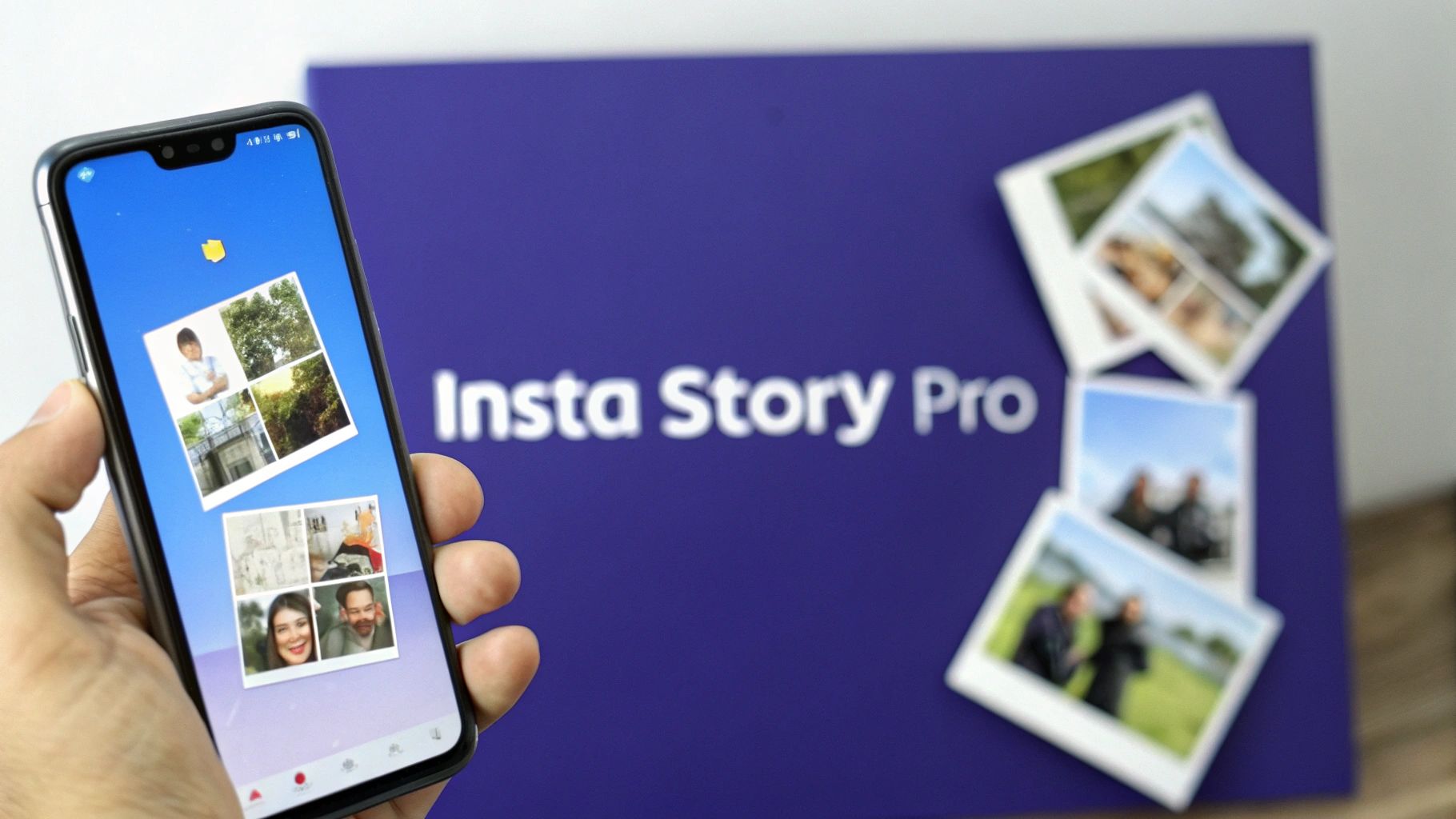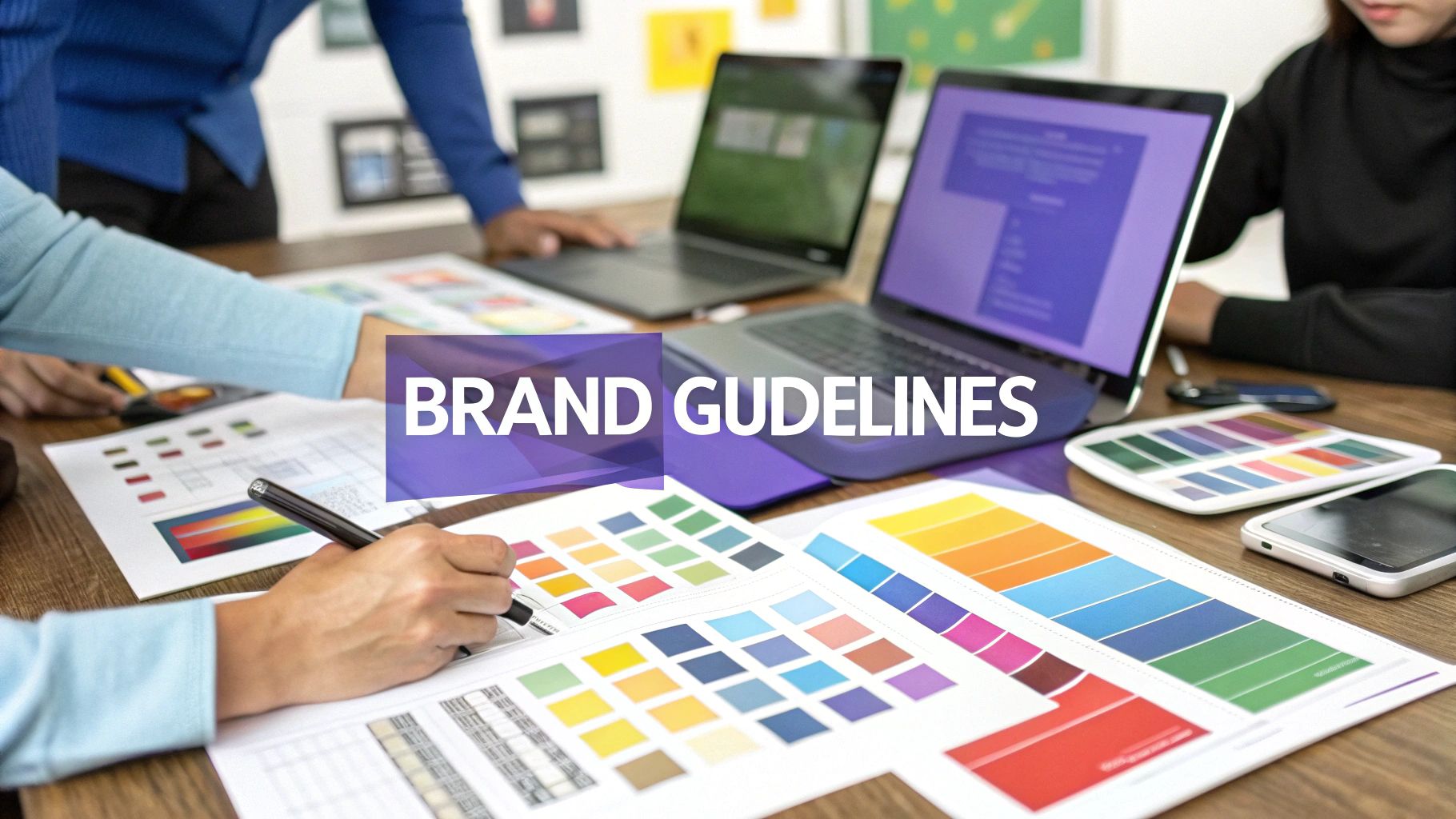In a saturated digital marketplace, a standard social media presence no longer guarantees visibility. The brands that capture attention and cultivate loyal followings do so with calculated, innovative strategies. Simply posting content is not a strategy; true success comes from a well-defined plan executed with precision.
This guide moves past abstract concepts to dissect real-world social media strategies examples from top-performing brands. We will break down the specific tactics behind successful campaigns, from user-generated content and influencer partnerships to community building and viral challenges. By examining what makes these approaches effective, you will gain a clear understanding of the mechanics behind exceptional social media performance.
The goal is to provide a blueprint you can adapt and apply directly to your own work. Each example is curated to offer actionable takeaways and replicable methods, equipping you with the insights needed to refine your approach. Whether your objective is to amplify engagement, increase conversions, or build a resilient brand identity, the strategies detailed here offer the practical inspiration required to achieve tangible results. Let’s explore the frameworks that drive growth and set brands apart.
1. User-Generated Content (UGC) Campaigns
One of the most powerful social media strategies examples today is harnessing user-generated content (UGC) to build authenticity and trust. A UGC campaign encourages your audience to create and share content featuring your brand, product, or service. This approach effectively turns customers into brand advocates, leveraging their authentic experiences to drive engagement and expand your reach organically.
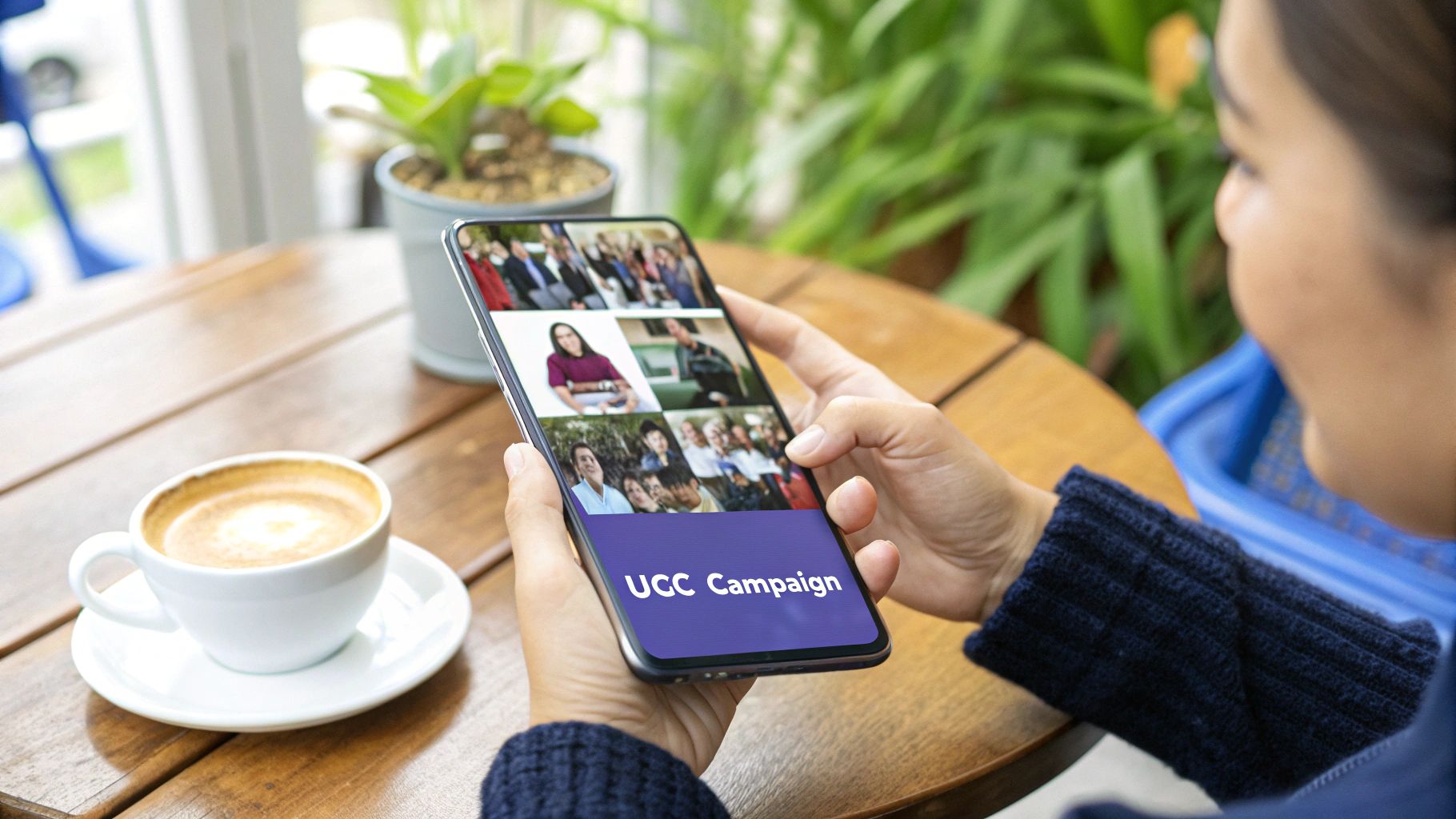
This strategy works because modern consumers trust peer recommendations far more than traditional advertising. When a potential customer sees real people enjoying a product, it acts as a powerful social proof. A well-executed UGC campaign can generate a massive library of authentic marketing assets at a fraction of the cost of professional content creation. For brands looking to understand this trend better, exploring the dynamics behind the rise of user-generated content marketing can provide valuable context.
Strategic Breakdown: GoPro's "Photo of the Day"
GoPro's entire marketing model is a masterclass in UGC. Instead of just selling a camera, they sell a lifestyle of adventure, all captured by their users.
- Tactic: The brand consistently runs contests like the "Photo of the Day" and the "GoPro Awards," incentivizing users to submit their best shots and videos.
- Platform: Primarily Instagram, YouTube, and their own website.
- Outcome: GoPro's social media feeds are a constant stream of high-quality, thrilling content that perfectly showcases the product's capabilities in extreme conditions. This builds a vibrant community and a self-sustaining content engine.
Key Insight: GoPro doesn't just ask for content; it celebrates the creators. By featuring users on their official channels and offering significant rewards, they make their community the hero of the brand's story.
Actionable Takeaways for Your Brand
- Create a Branded Hashtag: Launch a clear, memorable, and unique hashtag (like Starbucks' #RedCupContest) to easily track and curate submissions.
- Offer Clear Incentives: Motivate participation by offering compelling prizes, discounts, or the chance to be featured on your brand's official social media accounts.
- Set Guidelines, But Encourage Creativity: Provide simple rules for submission but allow your audience the creative freedom to produce authentic content.
- Repurpose with Permission: Always ask for permission before using UGC in other marketing materials like emails, ads, or your website.
To delve deeper into this strategy, you can explore more examples of successful UGC campaigns on postsyncer.com.
2. Influencer Partnership Marketing
Another one of the most effective social media strategies examples is influencer partnership marketing. This approach involves collaborating with individuals who have established credibility and a dedicated following in a specific niche. By leveraging an influencer's trust and connection with their audience, brands can authentically promote products or services, cutting through the noise of traditional advertising.
This strategy capitalizes on the power of word-of-mouth marketing in the digital age. Followers view influencers as trusted peers, making their endorsements more persuasive than a direct brand message. A successful influencer partnership doesn't just showcase a product; it integrates it into a lifestyle that the audience already admires and aspires to, driving both brand awareness and sales conversions.
Strategic Breakdown: Daniel Wellington's Rise with Micro-Influencers
Daniel Wellington (DW) is a prime example of a brand built almost entirely through influencer marketing. Instead of targeting a few mega-celebrities, DW focused on collaborating with thousands of micro-influencers across Instagram.
- Tactic: The brand gifted its minimalist watches to a vast network of fashion and lifestyle influencers, asking them to post photos featuring the watch along with a unique discount code for their followers.
- Platform: Primarily Instagram.
- Outcome: This created a widespread, seemingly organic trend. Feeds were filled with high-quality, aspirational photos of the watches, making them appear ubiquitous and highly desirable. The discount codes also made tracking ROI for each partnership straightforward.
Key Insight: Daniel Wellington mastered the art of scale and aesthetic consistency. By focusing on micro-influencers, they achieved massive reach at a lower cost and maintained a cohesive, aspirational brand image across thousands of individual accounts.
Actionable Takeaways for Your Brand
- Prioritize Alignment Over Reach: Choose influencers whose personal brand, values, and audience demographics perfectly match your target customer. High engagement on a smaller, relevant account is often more valuable than low engagement on a massive one.
- Establish Clear Goals and KPIs: Define what success looks like before you start. Is it brand awareness, website traffic, or direct sales? Track metrics like reach, engagement rate, referral traffic, and conversion rates from unique discount codes.
- Grant Creative Freedom: Provide clear guidelines, but trust the influencer to create content in their authentic voice. Their audience follows them for their unique style, and a post that feels like a stiff corporate ad will fall flat.
- Build Long-Term Relationships: Consider ongoing partnerships instead of one-off posts. A long-term collaboration builds deeper trust and authenticity with the influencer's audience over time.
3. Social Commerce Integration
A pivotal shift in digital marketing involves transforming social media platforms from discovery engines into direct sales channels. Social commerce integration is a strategy that embeds the entire shopping experience, from product browsing to checkout, directly within social apps like Instagram, Facebook, and TikTok. This approach drastically reduces friction in the customer journey, allowing users to purchase products the moment inspiration strikes, without ever leaving the platform.
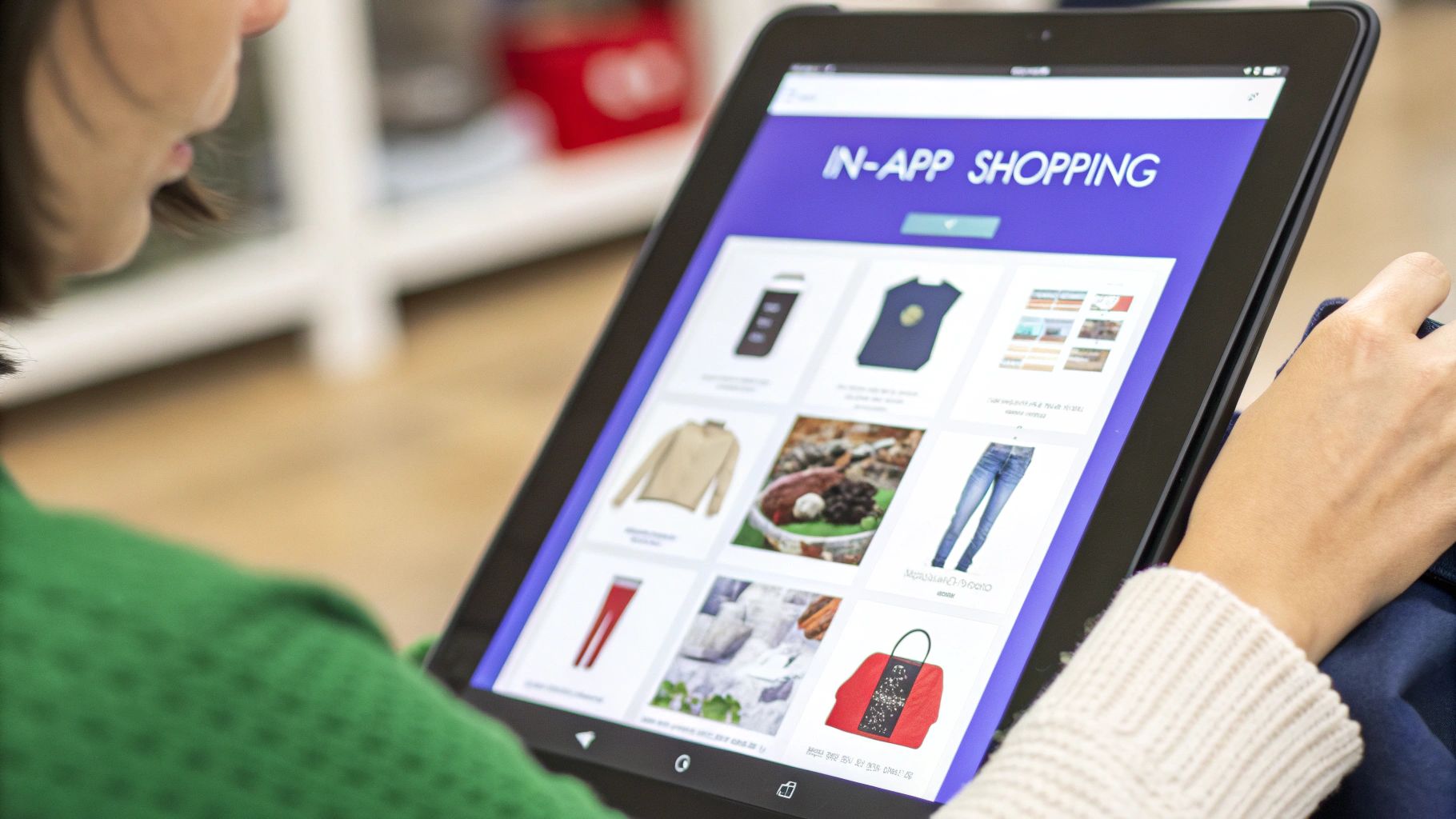
This strategy capitalizes on the impulse-driven nature of social media browsing. By making the path to purchase as seamless as possible, brands can significantly boost conversion rates and capture sales that might otherwise be lost when a user has to switch apps or navigate a complex website. For businesses looking to maximize their online sales funnels, integrating social commerce is one of the most effective social media strategies examples to consider.
Strategic Breakdown: Allbirds' Instagram Shop
Shoe brand Allbirds excels at using social commerce to turn its visually appealing Instagram feed into a powerful sales tool. They blend lifestyle content with shoppable posts, making the transition from browsing to buying feel natural and intuitive.
- Tactic: Allbirds uses high-quality images and videos featuring their products in real-world settings. Each relevant post includes Instagram Shopping tags that allow users to tap on a product, see its price, and click through to purchase directly from the in-app product page.
- Platform: Primarily Instagram Shopping and Facebook Shops.
- Outcome: This creates a frictionless shopping experience that meets customers where they are already spending their time. It boosts direct sales from social media, shortens the sales cycle, and provides valuable data on which products resonate most with their social audience.
Key Insight: Allbirds succeeds by integrating commerce without disrupting the user experience. Their shoppable posts feel like organic content, not aggressive sales pitches, maintaining the brand's authentic and community-focused voice.
Actionable Takeaways for Your Brand
- Set Up Your Shops: Create and optimize your product catalog on Facebook Shops and Instagram Shopping. Ensure your product images, descriptions, and pricing are accurate and compelling.
- Tag Products Consistently: Make it a habit to tag products in all relevant posts, including feed images, Stories, and Reels, to maximize visibility and shopping opportunities.
- Create Shoppable Collections: Organize products into curated collections (e.g., "Summer Essentials," "New Arrivals") to guide the user's shopping journey and encourage multi-item purchases.
- Leverage Live Shopping: Use features like Instagram Live Shopping to host interactive events, demonstrate products in real-time, and drive urgency and immediate sales.
4. Community Building and Engagement
Beyond one-off campaigns, one of the most sustainable social media strategies examples is building a dedicated community. This long-term approach focuses on creating a space where customers can connect with the brand and each other, fostering loyalty that transcends transactional relationships. Instead of just pushing products, this strategy prioritizes interaction, support, and shared values to turn customers into a loyal tribe of brand advocates.
This strategy thrives because people have an innate desire to belong. When a brand successfully creates a community, it provides a sense of identity and connection for its members. This deepens the customer relationship, leading to higher retention rates, valuable feedback, and powerful organic marketing. For brands committed to this path, understanding the fundamentals is key; consider resources on mastering social media and community management to build a strong foundation.
Strategic Breakdown: Sephora's Beauty Insider Community
Sephora's Beauty Insider Community is a premier example of building a brand-owned ecosystem where engagement flourishes. It's more than a loyalty program; it's a dedicated platform for makeup enthusiasts.
- Tactic: Sephora created a forum-like space where members can ask questions, share product reviews, post photos of their makeup looks, and join brand-sponsored groups and challenges.
- Platform: A dedicated hub on their website, which is heavily promoted across their social media channels like Instagram and Facebook.
- Outcome: The community generates a massive amount of authentic UGC and peer-to-peer advice, effectively reducing customer service loads. It also provides Sephora with invaluable, direct-from-consumer insights into product performance and trends.
Key Insight: Sephora empowered its most passionate customers. By giving them a platform to be the experts, they built a self-moderating, highly engaged community that adds immense value to the shopping experience.
Actionable Takeaways for Your Brand
- Define Clear Community Guidelines: Establish a positive and safe environment by setting clear rules for interaction and moderation.
- Provide Exclusive Value: Offer community-only content, early access to products, or special Q&A sessions to make membership feel rewarding.
- Facilitate Peer-to-Peer Interaction: Use conversation prompts, weekly threads, or challenges to encourage members to talk to each other, not just to your brand.
- Humanize Your Brand: Share behind-the-scenes content and have team members (not just social media managers) actively participate in discussions.
For a more comprehensive guide, learn more about how to build an online community on postsyncer.com.
5. Viral Challenge and Hashtag Campaigns
One of the most explosive social media strategies examples is the creation of a viral challenge or hashtag campaign. This strategy involves designing an engaging, shareable activity that encourages widespread participation. By using a catchy hashtag, simple participation rules, and often tapping into cultural moments, these campaigns can achieve massive organic reach and user engagement, effectively turning an audience into active participants in a brand's story.
This approach capitalizes on the human desire for connection, competition, and entertainment. When users see their peers participating, the fear of missing out (FOMO) kicks in, creating a powerful network effect. A well-executed viral challenge not only boosts brand awareness exponentially but also generates a vast amount of user-generated content, all neatly organized under a single hashtag.
The infographic below outlines the essential process flow for launching a successful campaign.
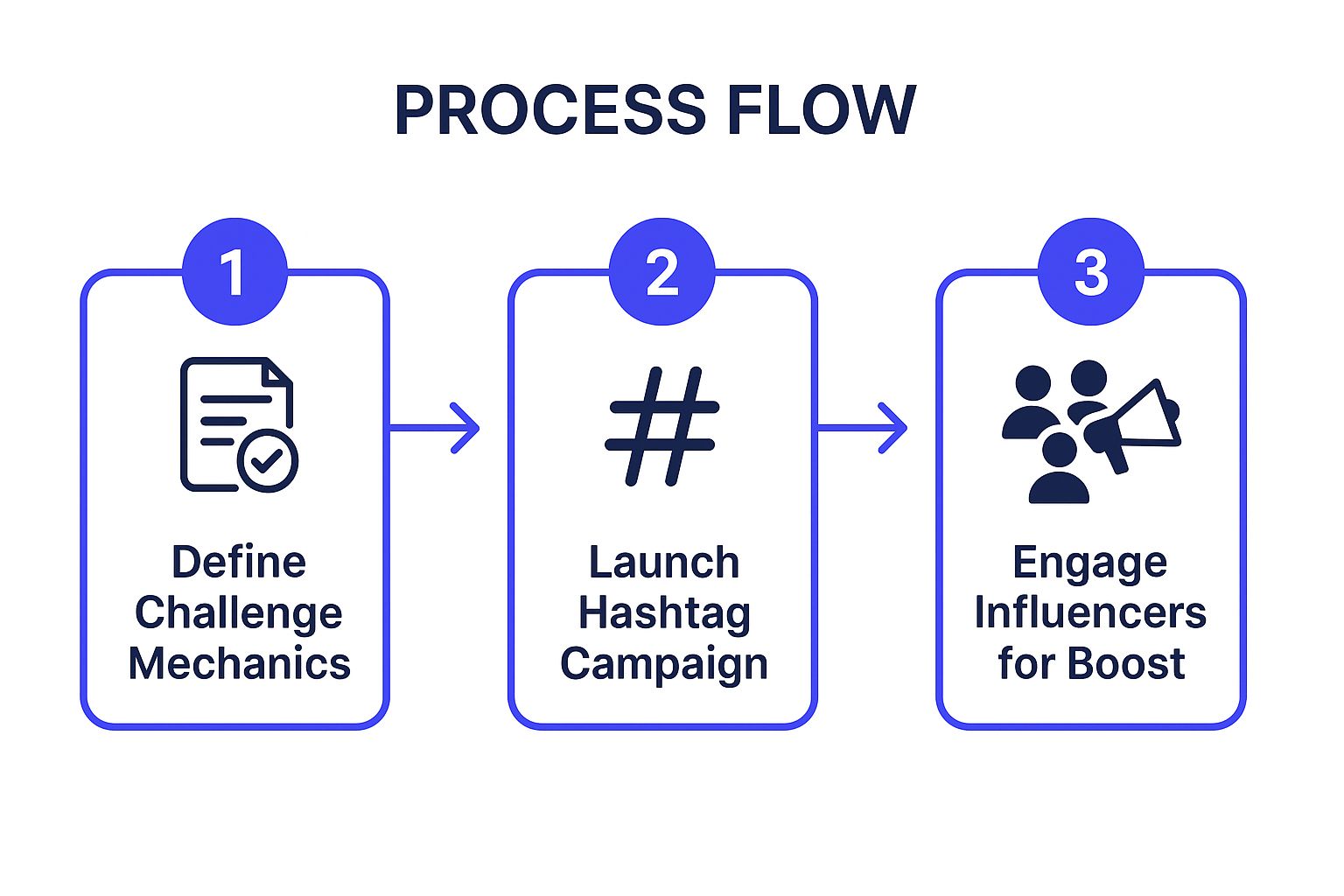
This visual guide emphasizes a structured approach, showing how a clear plan, a strong hashtag, and strategic promotion are sequential pillars for virality.
Strategic Breakdown: ALS Association's "Ice Bucket Challenge"
Perhaps the most famous viral campaign ever, the "Ice Bucket Challenge" transcended marketing to become a global phenomenon for a cause.
- Tactic: Participants were challenged to dump a bucket of ice water over their heads, post the video, nominate others to do the same within 24 hours, and donate to the ALS Association.
- Platform: Primarily Facebook, but it quickly spread to Twitter, Instagram, and YouTube.
- Outcome: The campaign went viral globally, raising over $115 million for the ALS Association in just one summer. It dramatically increased awareness of the disease and became a textbook example of cause-based viral marketing.
Key Insight: The campaign’s genius was its simple, highly visual, and easily replicable mechanic combined with a peer-to-peer nomination system. This created a self-perpetuating cycle of participation that felt personal and urgent.
Actionable Takeaways for Your Brand
- Make it Simple and Fun: The barrier to entry must be extremely low. If the challenge is too complex or requires special equipment, participation will drop off.
- Create a Unique Hashtag: Develop a clear, memorable, and unique hashtag that is easy to spell and directly relates to the campaign. To get started, you can learn how to find trending hashtags on postsyncer.com.
- Leverage Influencer Seeding: Kickstart the campaign by partnering with a few key influencers. Their initial participation can provide the social proof needed to trigger a wider organic spread.
- Engage with Participants: Actively monitor the hashtag, and share, comment on, and celebrate user submissions to encourage more people to join in.
6. Social Listening and Real-Time Marketing
One of the most agile social media strategies examples is using social listening for real-time marketing. This proactive approach involves monitoring online conversations, trends, and cultural moments to create timely and relevant content. By capitalizing on what your audience is talking about right now, you can insert your brand into the conversation organically and generate significant buzz.
This strategy works because it taps into the immediacy of social media, making a brand feel current, human, and witty. When done correctly, it can lead to viral moments that achieve massive reach at a minimal cost. For brands looking to improve their responsiveness, understanding the fundamentals of how to use social listening tools is an essential first step.
Strategic Breakdown: Oreo's "Dunk in the Dark"
Oreo's "Dunk in the Dark" tweet is the gold standard of real-time marketing. During the 2013 Super Bowl, a power outage plunged the stadium into darkness, and Oreo's marketing team seized the moment.
- Tactic: Within minutes of the blackout, Oreo tweeted a simple, timely image with the caption, "Power out? No problem. You can still dunk in the dark."
- Platform: Twitter (now X).
- Outcome: The tweet went viral almost instantly, garnering thousands of retweets and mentions. It overshadowed many multi-million dollar TV commercials and cemented Oreo's reputation as a nimble, clever, and culturally aware brand.
Key Insight: Oreo succeeded because they were prepared. They had a "mission control" team of decision-makers on standby, allowing them to create, approve, and post content in minutes, not hours or days.
Actionable Takeaways for Your Brand
- Invest in Social Listening Tools: Use tools like Brand24 or Sprout Social to monitor keywords, brand mentions, and emerging trends in real-time.
- Establish a Rapid Approval Process: Create a streamlined chain of command to get timely content approved quickly. Agility is the key to capitalizing on fleeting moments.
- Maintain Brand Voice Consistency: Ensure that all real-time responses, no matter how quick, align perfectly with your established brand personality.
- Know When to Stay Silent: Not every trend is right for your brand. Be discerning and avoid jumping into sensitive or controversial conversations that could cause backlash.
To learn more about implementing this strategy, you can explore further examples and guides on real-time marketing from HubSpot.
7. Educational Content and Thought Leadership
A content-driven approach that solidifies your brand as an industry authority is creating and sharing valuable educational content. This social media strategy example focuses on providing genuine expertise and insights, building trust and credibility with your audience. Instead of direct promotion, you offer solutions, data, and knowledge, positioning your brand as the go-to resource in your niche.

This method works because it addresses the core needs and pain points of your target audience, fostering a loyal community that values your brand for its expertise, not just its products. By consistently delivering high-quality educational material, you attract qualified leads who are already invested in the solutions you provide. Brands like Moz have built their reputation by sharing deep SEO research and tutorials, demonstrating the power of this approach.
Strategic Breakdown: HubSpot's Content Ecosystem
HubSpot is a prime example of a brand built almost entirely on educational content and thought leadership. Their social media channels are extensions of a massive knowledge hub designed to help marketers and sales professionals succeed.
- Tactic: HubSpot offers free, comprehensive resources like the HubSpot Academy (with certifications), detailed blog posts, research reports, and templates. They promote these assets across social media, driving traffic and generating leads.
- Platform: Primarily LinkedIn, Twitter, and Facebook, where they share blog snippets, infographics, video tutorials, and industry statistics.
- Outcome: HubSpot has become synonymous with inbound marketing education. This strategy generates a massive volume of organic leads and has cultivated a dedicated community that trusts their software because they first trusted their expertise.
Key Insight: HubSpot provides immense value upfront with no strings attached. By solving their audience's problems for free, they build unparalleled trust, making the transition from a content consumer to a paying customer a natural next step.
Actionable Takeaways for Your Brand
- Solve Real Problems: Identify the biggest challenges your audience faces and create content that provides clear, actionable solutions.
- Use Data and Research: Back up your claims with original research, statistics, and case studies to establish credibility and authority.
- Vary Your Content Formats: Repurpose your core insights into different formats like short-form videos, carousels, detailed articles, and downloadable guides to appeal to diverse learning preferences.
- Showcase Team Expertise: Encourage your team members to share their knowledge on platforms like LinkedIn. This humanizes your brand and highlights the depth of your internal talent.
7 Key Social Media Strategies Compared
| Strategy | Implementation Complexity 🔄 | Resource Requirements 🔄 | Expected Outcomes 📊 | Ideal Use Cases 💡 | Key Advantages ⭐ |
|---|---|---|---|---|---|
| User-Generated Content (UGC) Campaigns | Medium - requires content moderation and engagement management | Low to Medium - limited paid resources, relies on user participation | High engagement, authentic trust, organic reach | Building community, boosting brand awareness | Cost-effective, authentic content, higher engagement |
| Influencer Partnership Marketing | High - managing partnerships and compliance | High - influencer fees and campaign management | Increased targeted reach, measurable ROI | Targeted audience reach, brand endorsements | Access to engaged audiences, professional content |
| Social Commerce Integration | Medium to High - technical integration needed | Medium - platform fees and maintenance | Direct sales, reduced purchase friction | Brands seeking streamlined social to purchase funnel | Increased revenue, seamless shopping experience |
| Community Building and Engagement | High - requires ongoing content and interaction | High - continuous management and support | Strong customer loyalty, word-of-mouth marketing | Long-term brand advocacy and feedback channels | Deep customer relationships, valuable insights |
| Viral Challenge and Hashtag Campaigns | Medium - designing viral mechanics and monitoring | Low to Medium - depends on scale/influencers | Potential massive organic reach, high user participation | Brand awareness spikes, viral content creation | Cost-effective buzz, user-generated content surge |
| Social Listening and Real-Time Marketing | High - requires 24/7 monitoring and fast content creation | High - tools and rapid response team | High engagement, increased brand relevance | Capitalizing on trends and cultural moments | Timely visibility, brand personality showcase |
| Educational Content and Thought Leadership | High - significant research and consistent content creation | Medium to High - expertise and production | Builds authority, attracts quality leads | Positioning as industry expert, long-term trust | Credibility, SEO benefits, evergreen content |
From Inspiration to Implementation: Your Next Steps
We've journeyed through a diverse landscape of powerful social media strategies examples, from the authentic buzz of User-Generated Content campaigns to the authority-building power of educational content. The successes of brands like Glossier, Duolingo, and Spotify are not accidents; they are the result of deliberate, audience-centric strategies that combine creativity with keen strategic insight. Each example serves as a blueprint, demonstrating that there is no single "correct" way to win on social media.
The common thread weaving through all these successful approaches is a deep understanding of a specific audience and the value they seek. Whether it's the entertainment of a viral challenge, the connection of a thriving online community, or the utility of an integrated social commerce feature, the goal is always to deliver a meaningful experience. Your brand's unique voice, business objectives, and customer needs will ultimately determine which of these blueprints is the right one to adapt.
Distilling the Core Principles
As you move from inspiration to action, remember these foundational takeaways that underpin nearly every effective social media strategy:
- Authenticity Over Polish: Audiences crave genuine connection. UGC campaigns and transparent influencer partnerships resonate because they feel real and relatable, building trust more effectively than overly produced advertisements.
- Community is a Moat: A highly engaged community is your brand's most defensible asset. Investing in community-building and active social listening creates loyal advocates who will amplify your message and provide invaluable feedback.
- Value Precedes the Ask: Before you can sell, you must serve. Providing educational content, entertaining videos, or a platform for user expression builds goodwill and positions your brand as a valuable resource, not just a seller of goods.
- Agility is a Superpower: The digital world moves fast. Brands that excel at real-time marketing and can pivot to join relevant conversations demonstrate an agility that keeps them top-of-mind and culturally relevant.
Your Actionable Roadmap to Success
Feeling inspired is the first step, but implementation is what drives results. Don't try to tackle everything at once. Instead, adopt a methodical approach to integrate these powerful strategies into your own marketing efforts.
- Conduct a Strategy Audit: Review your current social media performance. Where are your biggest opportunities? If engagement is low, perhaps a community-building initiative is your best starting point. If you need more content, a UGC campaign could be the answer.
- Select and Pilot One Strategy: Choose the single strategy from our list of social media strategies examples that best aligns with your immediate goals and resources. Define clear, measurable key performance indicators (KPIs) to track its success over a specific period, such as 90 days.
- Develop a Content Plan: Break down the chosen strategy into a tangible content calendar. What posts will you need? What assets must be created? Who is responsible for execution? A detailed plan removes guesswork and ensures consistency.
- Measure, Learn, and Iterate: At the end of your pilot period, analyze the data. What worked? What didn’t? Use these insights not as a final judgment but as a learning opportunity to refine your approach before scaling it or testing a new strategy. Mastering social media is an iterative process of testing and optimization.
Turning these sophisticated strategies into a seamless workflow requires the right tools. PostSyncer provides the all-in-one platform you need to schedule diverse content, manage community engagement, and analyze performance metrics in a single dashboard. Stop juggling multiple tabs and start executing your vision with clarity and efficiency by visiting PostSyncer.













